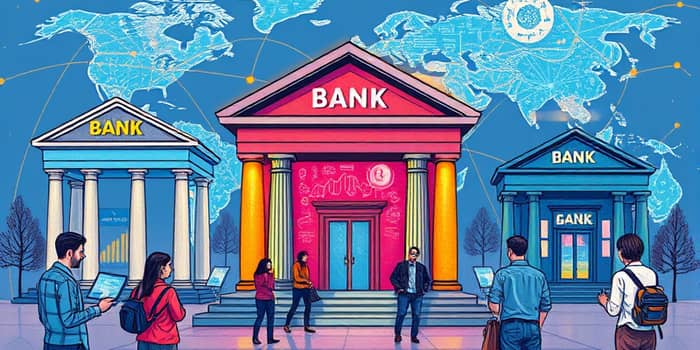Open banking represents a paradigm shift in the way consumers, banks, and fintechs collaborate to deliver financial products and services. By embracing secure, regulated access to consumer data through APIs, this model promises a future where financial interactions are more transparent, efficient, and tailored to individual needs.
In the coming years, open banking will not only redefine digital banking experiences but also foster unprecedented innovation across all corners of the financial ecosystem.
What is Open Banking?
At its core, open banking is a financial model that enables third-party providers (TPPs) to access consumer financial information held by traditional banks via APIs. This access is granted under strict regulatory oversight, ensuring that customer consent and data privacy remain paramount.
The architecture relies on robust API frameworks and encryption standards, creating an environment where new services can flourish without compromising security.
Key participants include:
- Banks providing core financial infrastructure
- Fintech companies driving innovation
- Merchants integrating payment solutions
- End consumers controlling their data
Market Growth and Projections
The open banking market has witnessed remarkable expansion, reaching between $28.2 billion and $38.7 billion in value during 2024 and 2025. Driven by regulatory mandates and consumer demand, the sector is set for explosive growth in the next decade.
Analysts project a compound annual growth rate ranging from 16.6% to over 27%, with the global market potentially soaring to $136–$180 billion by 2030–2032 and reaching $306 billion by 2035.
Furthermore, API call volumes are set to increase from 137 billion in 2025 to 722 billion by 2029, illustrating the breadth of interactions between banks, fintechs, and consumers in real time.
Regional Trends and Regulatory Landscape
Europe currently leads the open banking revolution, accounting for roughly 38% of global revenue in 2023. This maturity is largely the result of PSD2 mandates, which compelled banks to offer open, standardized APIs to licensed TPPs.
Meanwhile, the Asia-Pacific region has emerged as the fastest-growing market. Government initiatives such as India’s Unified Payments Interface (UPI) and Australia’s Consumer Data Right (CDR) have accelerated adoption, highlighting regional commitment to digital finance innovation.
In the United Kingdom alone, the open banking ecosystem serves over 10 million active users, including both consumers and small businesses. All major UK banks support comprehensive services, from account aggregation to Variable Recurring Payments (VRPs).
Key Drivers of Adoption
The rapid uptake of open banking is underpinned by several key factors:
- Regulatory support for data sharing mandates
- Rising consumer demand for personalized services
- Advances in AI, cloud computing, and real-time payments
- Significant fintech investment and collaboration
These drivers have created an ecosystem where banks and fintechs can collaborate effectively, resulting in faster product development cycles and improved customer experiences.
Benefits Across the Ecosystem
Open banking delivers a range of benefits that extend across consumers, financial institutions, and third-party innovators.
For consumers, this model brings:
- Faster access to credit, loans, and budgeting tools.
- Customized financial products tailored to individual behavior.
- More transparent fee structures and cost-effective services.
- Seamless digital experiences available 24/7 without paper.
Financial institutions benefit from operational agility, automated compliance processes, and new revenue streams through partnership opportunities. Meanwhile, fintechs can leverage API ecosystems to introduce services such as buy-now-pay-later (BNPL), automated savings, and instant payments with unparalleled speed.
Innovative Use Cases
Open banking has already given rise to an impressive array of real-world applications that demonstrate its transformative potential.
- Personal financial management and budgeting apps that aggregate multiple accounts in one view.
- Instant credit offers and buy-now-pay-later solutions embedded directly into e-commerce checkouts.
- Real-time peer-to-peer payments and money transfers powered by API-driven networks.
- Automated savings and investment tools that allocate funds based on spending patterns.
- Payment initiation and seamless checkout services enabling frictionless digital purchases.
These use cases illustrate how open banking can enhance financial inclusion, improve user experiences, and foster a more dynamic market landscape.
Challenges and Safeguards
Despite its promise, open banking introduces new risks that must be carefully managed. Security concerns arise from the increased attack surface created by third-party integrations, while privacy issues demand clear consumer consent and transparency about data usage.
Regulatory compliance remains a moving target, with banks and fintechs required to adapt continuously to evolving standards. Moreover, legacy infrastructure in traditional banks can complicate API implementation, leading to integration challenges.
To mitigate these risks, organizations are investing in advanced encryption, multi-factor authentication, and robust fraud detection systems powered by AI. Establishing clear governance frameworks and standardized API protocols is also essential to maintaining consumer trust and safeguarding data.
Future Outlook
The future of open banking points toward an even broader concept of “open finance,” where data sharing and collaboration extend beyond traditional banking into insurance, investment, and non-financial sectors. As technology evolves, we can expect:
- Deeper integration of AI for personalized financial guidance.
- Growth of embedded finance solutions within non-bank apps.
- Expansion of IoT-connected finance through smart devices.
- The emergence of API marketplaces that simplify service discovery and integration.
By 2035, open banking is likely to be the standard framework for financial interactions, unlocking new opportunities for innovation, competition, and consumer empowerment across the globe.
As the model matures, stakeholders must remain vigilant about security, governance, and inclusivity to ensure that the benefits of open banking are realized by all.
References
- https://payio.co/benefits-of-open-banking/
- https://www.imarcgroup.com/open-banking-market
- https://plaid.com/resources/banking/what-is-open-banking/
- https://www.globenewswire.com/news-release/2025/07/22/3119535/0/en/Open-Banking-Market-Size-to-Surpass-USD-180-31-Billion-by-2032-at-25-63-CAGR-Research-by-SNS-Insider.html
- https://www.netguru.com/blog/open-banking-trends
- https://www.futuremarketinsights.com/reports/open-banking-market
- https://internationalbanker.com/banking/why-2025-is-set-to-be-a-pivotal-year-for-open-banking/
- https://www.researchandmarkets.com/reports/5939342/open-banking-market-report
- https://stripe.com/resources/more/open-banking-explained
- https://www.marknteladvisors.com/research-library/open-banking-market.html
- https://www.f5.com/glossary/open-banking
- https://www.gminsights.com/industry-analysis/open-banking-market
- https://www.jpmorgan.com/payments/payments-unbound/magazine/articles/open-banking-internet-of-money
- https://www.mckinsey.com/industries/financial-services/our-insights/global-banking-annual-review
- https://www.decta.com/company/media/open-banking-benefits
- https://www.deloitte.com/us/en/insights/industry/financial-services/financial-services-industry-outlooks/banking-industry-outlook.html
- https://www.mastercard.com/us/en/news-and-trends/stories/2024/what-is-open-banking-your-essential-guide.html
- https://www.juniperresearch.com/research/fintech-payments/banking/open-banking-apis-market-research-report/










